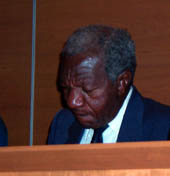 
|
||
|
5th Meeting of the Subsidiary Bodies for Scientific,Technical and Technological Advice (SBSTTA) of the Convention on Biodiversity (CBD). Montréal,
CANADA |
||
|
|
||
|
Tuesday 01 February : On Monday 31 January, Delegates met in Plenary to hear opening statements, adopt the agenda, and agree upon the organization of work. Substantive discussion began on cooperation with other bodies, the Global Taxonomy Initiative, inland waters biodiversity, forest biodiversity, the Clearing House Mechanism and guidelines for the second national reports. Opening Statements:
Side Events : Millennium Ecosystem Assessment:
With a clearly defined vision, the Millennium Assessment (MA) has 3 defining features:
More information can be found out about the MA at its website : [http://www.ma-secretariat.org/] CBD Clearing House Mechanism (CHM) Marc Auer and Beatriz Torres of the CBD Secretariat's CHM, supply information to CHM National Focal Points at their side event. Link: [http://www.biodiv.org/chm/] Pictured left to right: Brett Orlando (IUCN), Jordan West (IUCN), Patricia Glick (National Wildlife Federation), and Alan Strong (National Oceanic and Atmospheric Administration).
Jordan West, Marine Science Advisor for IUCN, outlined that coral bleaching is a phenomenon which happens when coral is exposed to stresses such as pollution, fresh water run-off, sedimentation, abrupt salinity fluctuations, and most commonly, oceanic temperature changes. Such stress deteriorates the symbiotic relationships between corals and resident algae, threatening integral resources that corals provide. Coral reefs provide nutritional and structural resources to fisheries, they protect terrestrial shorelines from erosion, they are sources of bioactive compounds with pharmaceutical applications, they provide tourism income for many countries, and as "rainforests of the sea", coral reefs are depositories of genetic material and biological diversity. The problem has opened eyes to the weakened state of coral systems around the world, and their vulnerability to climate change and oceanic temperature fluctuations. Temperature excesses have been so severe that there has been high proportion of mortality in corals, which take decades to regenerate. According to Alan Strong, Oceanographer with the National Oceanic and Atmospheric Administration (NOAA), if such temperature increases such as those experienced in the last 10 years continue through the next decade, there is real reason for concern. With increased intensity and mortality of recent coral bleaching events (such as the 1997-1998 "el niño"), and the likelihood of future mortalities, the group suggests that more research, monitoring, and coordination at the international level need to be prioritized. Brett Orlando, Climate Change Program Officer at IUCN suggests a need to re-evaluate management systems, recognizing opportunities to do so within the CBD to set an agenda through the Jakarta Mandate. Four potential areas of work to address coral reef conservation include:
There is reason to suspect that we are approaching an ecological limit, consistent with what most climate modelers have predicted. Patricia Glick, National Wildlife Federation, adds that there needs to be more collaboration among institutions and conventions. Links:
|
|
| |
| © 2000, International Institute for Sustainable Development (IISD). All rights reserved. |
|







